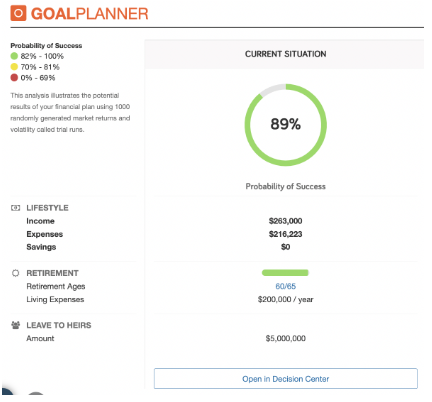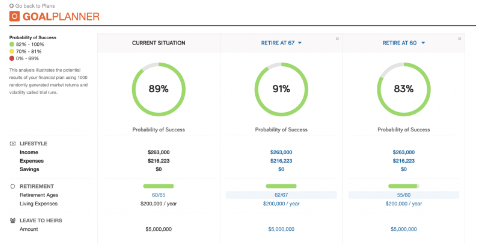Financial Planning Fridays #2: The Probability of Success
Welcome to Financial Planning Fridays, our weekly video series on the benefits of financial planning. Today we are going to focus on the probability of success in a financial plan.
In the financial planning software that we use from eMoney the probability of success is determined by running 1,000 random trials of your potential investment returns and volatility against your financial goals. This gives us the percentage chance that you will be able to reach all of your goals on time with your current investment allocation.

We can also run multiple scenarios side by side to see how making different planning changes will affect the percentage chance of success. In this example, we are looking at how different retirement dates are affecting the probability of success.

You can see how waiting to retire one extra year had a significant impact on her plan.
For longer-term goals, we are looking for a probability of success that is greater than 82%. If it is below 82% we will likely need to make a change to the plan, investment allocation or goals. We also track this percentage so that we can consider adjustments immediately if this figure begins to decline.
The top four things that affect your probability of success are:
1. Time until goal.
The longer you have until a desired goal, generally the easier it is to reach. The most common example of this is the year our clients decide to retire. We can look at a number of options in advance and see how this changes the probability of success.
2. Amount that you are saving or spending.
The program can tell us the maximum amount that you are able to spend each year while still keeping the chance of success above 82%. Alternatively, we can also find out how much sooner you are able to reach your goals if you increase your savings.
3. Asset allocation.
Often the greater amount that you are able to comfortably hold in stock for long-term goals the better. We will talk about this in more detail during a video specifically on asset allocation.
4. Minimizing taxes.
Reducing the amount of tax you pay before retirement, after retirement and ultimately from your estate can have a huge impact on your plan. We analyze a number of factors including the order of accounts to take withdrawals from, Roth conversions and potentially setting up trusts.
These are a few of the items that have an impact on the probability of success in your plan. There are many others, and they are often different from person to person.
Be on the lookout for our next Financial Planning Fridays episode. Subscribe to our Youtube Channel so you never miss an episode. Or contact us directly; schedule your 15-minute call with us today.
